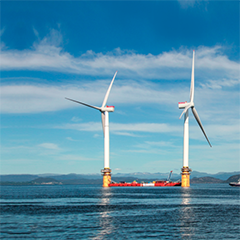How lessons from the oil and gas industry can support the floating offshore wind (FLOW) sector’s sustainable development
Floating offshore wind has the potential to substantially increase access to an unlimited energy resource in deeper waters, and can play a crucial role in driving the world’s transition to clean energy.
This paper examines the importance of adopting proven approaches from the offshore hydrocarbon sector to realise floating offshore wind’s successful commercialisation, drawing on comparisons between the sector’s current use of asset monitoring systems in pilot projects and the potential of the technology’s full-scale application. Going beyond model verification, it analyses how the technology can secure platforms throughout their entire lifecycles; mitigating risk to stakeholders, supporting array upscaling, and delivering the levelised cost of energy (LCoE) benefits of digitalisation.
As part of the worldwide aim for net-zero, or carbon neutrality, European leaders have committed to reaching a 32% renewables grid contribution by 2030 – up from 17.5% in 2017. Recognising the limitations of fixed bottom offshore wind, floating offshore wind (FLOW) is increasingly viewed as an integral part of this initiative. With consistent high-velocity winds, operating in deep waters has the potential to uplift FLOW’s capacity factor when compared with its fixed bottom counterpart. Illustrating FLOW’s advantageous position, the International Energy Agency expects the technology to achieve cost-savings of 50% by 2050, outperforming fixed bottom winds forecasted 35% cost-reduction. This projection is reinforced by the multi-national energy company, Equinor, which predicts that FLOW will arrive at a competitive levelised cost of energy (LCoE) of €40-60/MW by 2030.



























